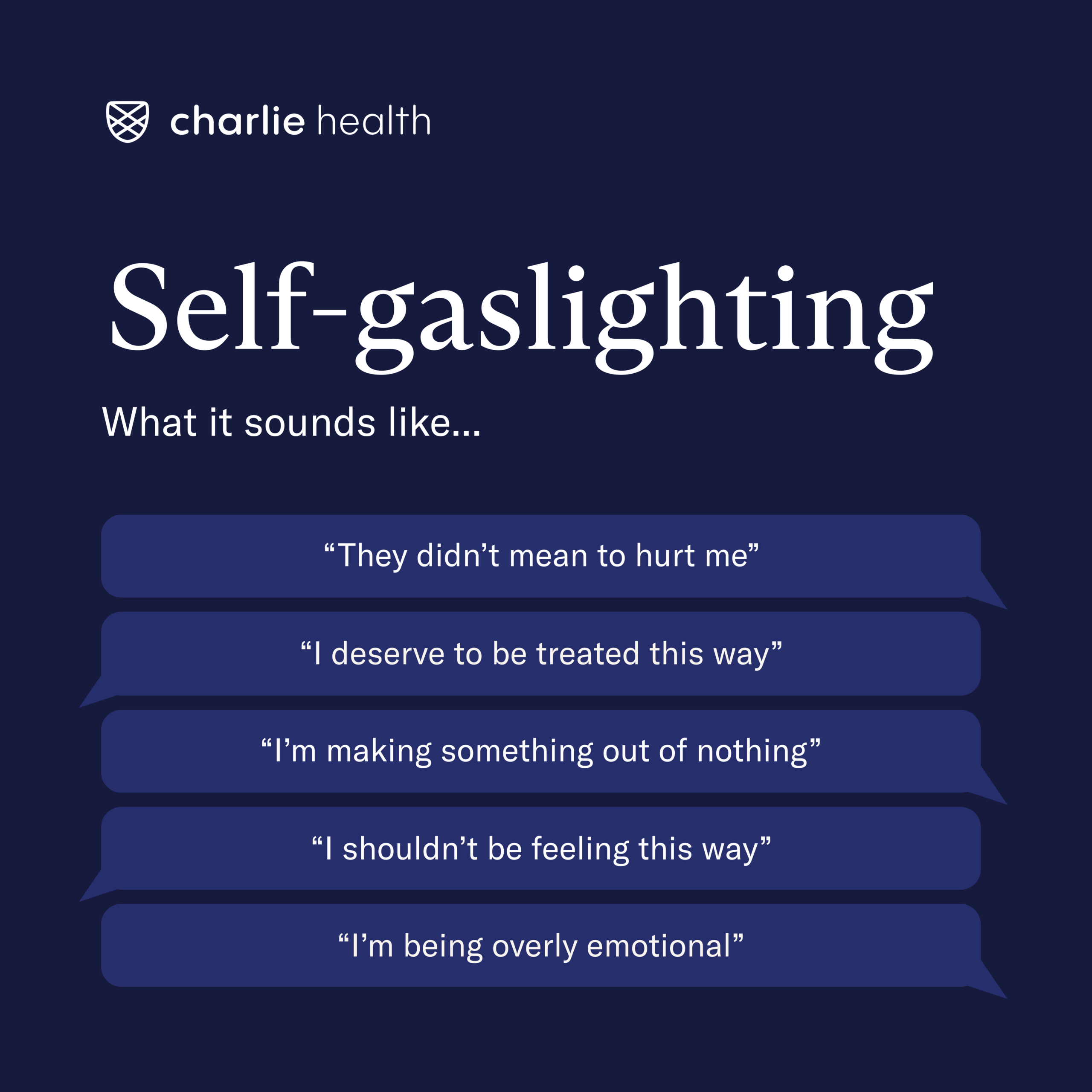
Self-Gaslighting Is Real—Here’s How to Stop It

Written By: Sarah duRivage-Jacobs

Clinically Reviewed By: Dr. Don Gasparini
Updated: November 21, 2023
6 min.
Childhood trauma, which more than half of U.S. adults have experienced, can lead to self-gaslighting. Here’s how to deal with it.
Learn more about our Clinical Review Process
Everyone has second-guessed or doubted their own feelings or perceptions at some point in life. But when that self-doubt is related to painful or distressing experiences, and you end up feeling responsible for the things that have happened to you, you may be dealing with something more serious: self-gaslighting.
For some people who’ve experienced trauma or have a history of abuse, self-gaslighting may be a defense mechanism used subconsciously to avoid confrontation with the trauma-related person or event. If you think you might be gaslighting yourself, keep reading to learn more about this behavior, understand where it comes from, and find out how therapy can help.

Healing from trauma is possible
Learn more about the best therapy to support your mental health.
What is self-gaslighting?
To fully understand self-gaslighting, it’s helpful to look at the origins of gaslighting, a method of manipulating someone to doubt their perceptions or experiences. The term, which first gained popularity from an eponymous 1930s and ‘40s film where a man manipulates his wife into doubting her reality, has become so commonly used since then that Merriam-Webster named it the 2022 word of the year. Gaslighting can happen in a range of relationships, including unhealthy romantic relationships or in romantic, familial, or platonic relationships with people who have narcissistic personality disorder.
Although “self-gaslighting” has yet to become as widely adopted, especially by mental health experts, in 2020, researcher-scholar Paige Bendt published a paper defining it as “a circumstance where the survivor of sexual assault self-induces themselves as the gaslighter and the gaslightee.”
In an article for Psychology Today, psychologist Ingrid Clayton, Ph.D., broadens the definition of self-gaslighting to encompass the internalization of any kind of abuse from another person and, as a result, distrusting one’s feelings and turning the blame inward.
Self-gaslighting can manifest as self-blaming, self-shaming, or otherwise holding oneself responsible for painful or traumatic events experienced. It is not a clinical diagnosis but rather a symptom of an underlying problem.

Self gaslighting examples
Self-gaslighting can show up in different ways for different people. The constant, however, is that someone is doubting their reality enough to question their own experience. Here are some examples of how self-gaslighting can look and sound:
- Convincing yourself that an experience of sexual assault wasn’t really sexual assault.
- Blaming yourself for ongoing verbal abuse from a family member.
- Telling yourself that what you experienced wasn’t trauma.
- Telling yourself that what you experienced wasn’t a big deal or wasn’t all that bad.
- Telling yourself you’re being too sensitive.
- Telling yourself to get over something you’ve decided you should already be over.
- Telling yourself that you deserved to be abused.

Is self-gaslighting common?
Self-gaslighting isn’t a diagnosis in and of itself, so it’s difficult to estimate how common the behavior is. That said, given that self-gaslighting can be defined as the internalization of abuse, we do have an outside figure to look to: According to the Centers for Disease Control and Prevention (CDC), more than half of adults in the U.S. have reported that they have experienced at least one adverse childhood experience—a term that covers abuse, neglect, and other forms of childhood trauma.
People who are more commonly subjected to gaslighting may, in turn, self-gaslight more often. For instance, researchers have identified how people of certain identities may be subject to specific forms of gaslighting, like racist gaslighting or parental gaslighting of transgender children.
Gaslighting is also often used in the context of the emotional abuse or manipulation of women, girls, or other people assigned female at birth, research shows. For thousands of years these individuals have been told that many of the issues they’re experiencing are “all in their heads.” The now-outdated diagnosis of “hysteria,” which comes from the Greek word for “uterus” (“hysteria”), was given to (predominantly “female”) people who sought medical help for unexplained physical illness.
While the diagnosis is no longer used today, we can see remnants of “hysteria” and “it’s all in their head” in gaslighting and self-gaslighting. We can also see it echoed when the pain of these individuals isn’t believed by medical professionals, which happens more often to women, girls, and those assigned female at birth who are also people of color.
Why do some people self-gaslight?
As mentioned, self-gaslighting is often a response to trauma. Trauma, which all of us experience to some degree, is the physical or emotional response to distressing life events like sexual assault, a natural disaster, an accident, the loss of a loved one, or another negative experience.
Rather than directing blame or anger toward the perpetrator of trauma or the trauma itself, self-gaslighting can be thought of as an example of the fawn response or people-pleasing—defense mechanisms used to protect oneself against discomfort, danger, or conflict. Shifting blame or anger can make things feel safer than confronting a traumatic experience head-on. The fawn response is more common among those who have been exposed to complex trauma like ongoing abuse or dysfunctional familial relationships.
People who have post-traumatic stress disorder (PTSD), a psychiatric disorder marked by intrusive thoughts, irritability, and angry outbursts, among other distressing symptoms, and sexual assault may be more likely to experience self-blame.
What are the risks of self-gaslighting?
There are a few different ways to understand the impact of self-gaslighting. First, research associates any form of gaslighting with extreme self-doubt as well as anxiety, depression, and addiction. Self-blame, which can be a component of self-gaslighting, can also be a contributor to major depressive disorder. Also, self-gaslighting can be a defense mechanism protecting someone from directly addressing trauma, so there can also be risks associated with the underlying trauma that has gone untreated. For young people, untreated trauma can lead to:
- Low self-esteem
- Feeling unsafe
- Emotional dysregulation
- Difficulty with attachment
- Interpersonal challenges
- Depression
- Anxiety
- Substance abuse
- Suicidality
If you’re experiencing suicidal thoughts and think you’re in danger of harming yourself, this is a mental health emergency—you can contact The Suicide & Crisis Lifeline 24/7 by calling or texting 988 or call 911 or go to an emergency room for immediate care.
How to stop self-gaslighting?
Since people who self-gaslight typically do it to protect themself against conflict, addressing the conflict—oftentimes rooted in trauma—is likely the most beneficial path forward. Adolescents who have a history of trauma may be best supported by the following two evidence-based and trauma-informed therapeutic modalities:
Trauma-focused cognitive behavioral therapy
Trauma-focused cognitive behavioral therapy (TF-CBT) is an effective mental health treatment for managing the effects of trauma. In TF-CBT, clients can learn to better understand trauma-related thoughts and behaviors, work to develop new skills and coping strategies and reduce the impact of trauma on symptoms and relationships.

Eye movement desensitization and reprocessing therapy
Eye movement desensitization and reprocessing (EMDR) therapy uses light or sound to stimulate one side of the brain and then the other while recalling the traumatic event(s) with the goal of decreasing the intensity of any distressing emotional effects related to trauma.
Find support for self-gaslighting at Charlie Health
If you’re dealing with self-gaslighting or trauma, Charlie Health is here to help.
Charlie Health’s virtual Intensive Outpatient Program (IOP) offers more than once-weekly supported groups, individual counseling, and family therapy for young people dealing with complex mental health conditions, including trauma. Our expert clinicians can help young people address trauma and trauma responses like self-gaslighting, establish healthy boundaries, and develop constructive coping strategies.
Fill out our short, free assessment to start healing with Charlie Health today.
References
https://dictionary.apa.org/gaslight
https://www.psychologytoday.com/us/blog/emotional-sobriety/202109/what-is-self-gaslighting
https://www.cdc.gov/violenceprevention/aces/fastfact.html
https://onlinelibrary.wiley.com/doi/10.1111/nuf.12588
https://www.aamc.org/news/how-we-fail-black-patients-pain
https://www.bbc.com/future/article/20180518-the-inequality-in-how-women-are-treated-for-pain
https://academic.oup.com/monist/article-abstract/102/2/221/5374582
https://www.tandfonline.com/doi/abs/10.1080/14681994.2018.1444274




